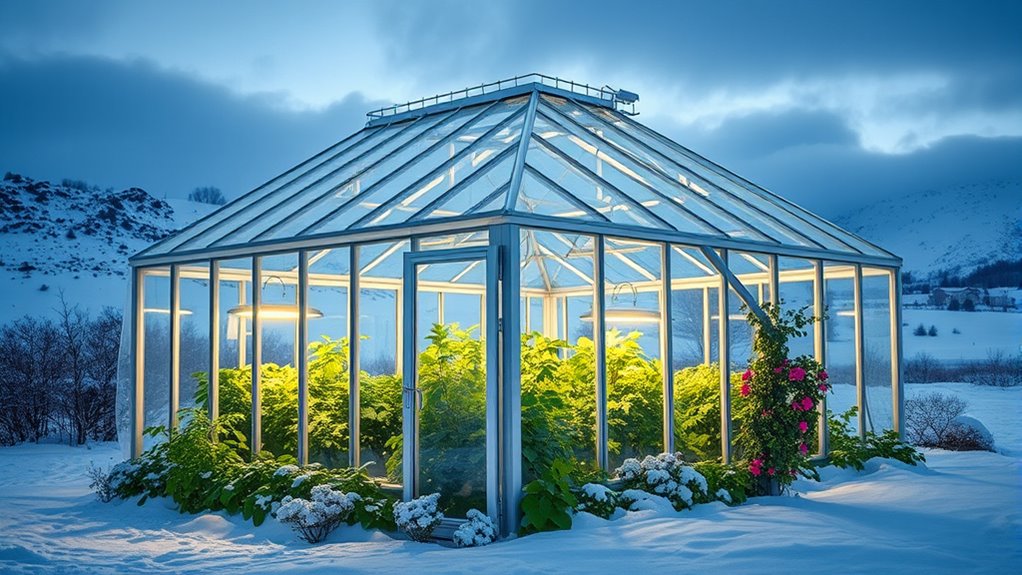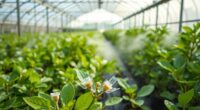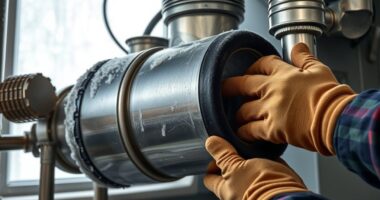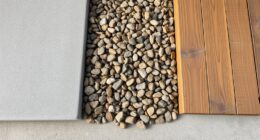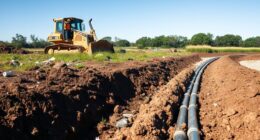To succeed in greenhouse gardening in extreme climates, focus on designing a strong structure with durable, weather-resistant materials like galvanized steel and UV-protected glazing. Use proper insulation, climate control, and water management techniques such as drip irrigation and rainwater harvesting. Protect your plants from wind, pests, and temperature fluctuations by selecting resilient species suited to harsh conditions. For detailed tips on building and maintaining your greenhouse in tough environments, continue exploring effective strategies.
Key Takeaways
- Design greenhouses with durable, weather-resistant materials like galvanized steel frames and UV-stabilized glazing to withstand extreme conditions.
- Incorporate insulation and thermal mass strategies, such as insulated panels and reflective materials, to maintain stable internal temperatures.
- Use climate control systems like passive solar heating, effective ventilation, and automated watering for temperature and water management.
- Select resilient plant species with pest resistance, drought tolerance, and adaptability to extreme temperature ranges.
- Implement external protections like windbreaks, insect screens, and shading to shield plants from external threats and harsh sunlight.
Designing a Resilient Greenhouse Structure
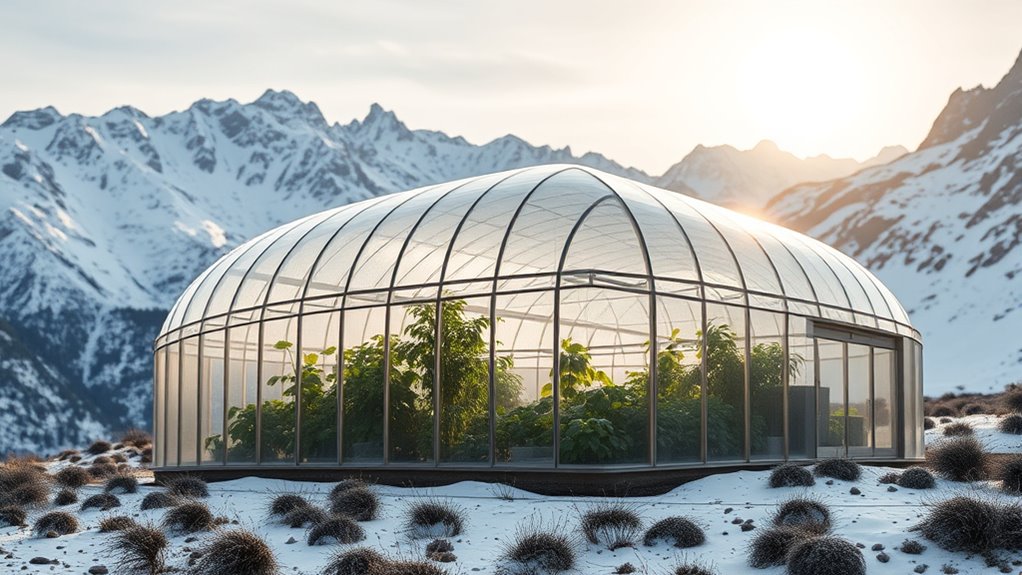
Creating a resilient greenhouse structure begins with selecting the right materials and design features that can withstand local weather conditions. To optimize energy efficiency, incorporate solar energy solutions like solar panels or passive solar design strategies that capture and utilize sunlight effectively. This not only reduces reliance on external power sources but also enhances sustainability. Incorporating good lighting options is essential for maintaining plant health and growth, especially in extreme climates. When considering aesthetic design, choose shapes and materials that blend with your environment while maximizing light transmission. A well-designed greenhouse should have a sturdy frame, weather-resistant glazing, and ventilation options to manage temperature fluctuations. Prioritizing these elements guarantees your greenhouse remains durable, energy-efficient, and visually appealing, providing a reliable environment for your plants—even in extreme climates. Additionally, selecting insulation materials that suit your climate can significantly improve temperature regulation and reduce energy costs. Employing climate-specific design features further ensures the structure can withstand harsh weather conditions while maintaining optimal growing conditions. Incorporating advanced weatherproofing techniques can also help protect your greenhouse from unexpected storms or temperature extremes.
Selecting Suitable Materials for Extreme Conditions
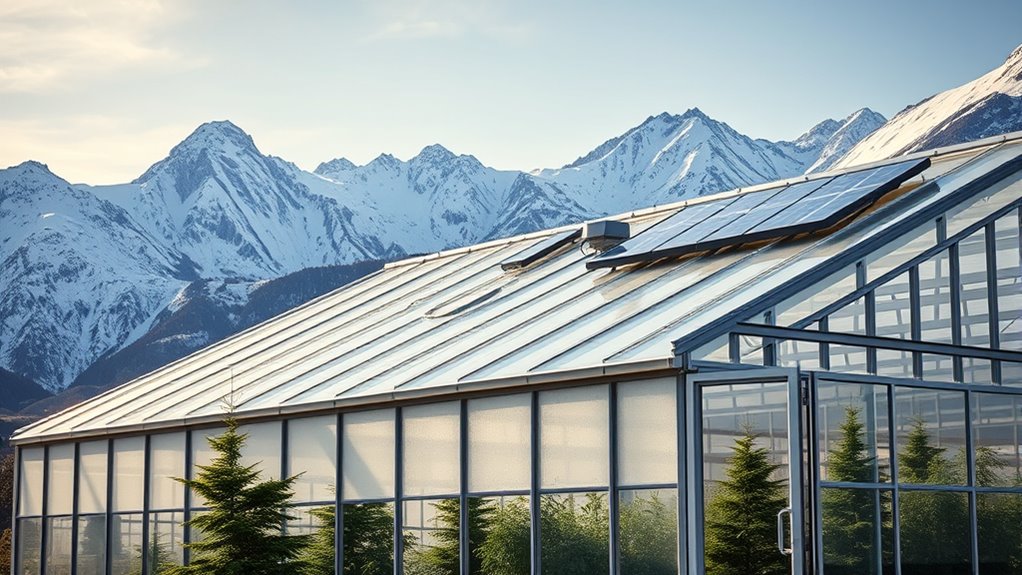
When choosing materials for extreme conditions, you need options that can withstand the elements. Consider insulation materials that keep temperatures stable, durable frames that resist corrosion, and UV-resistant coverings that prevent sun damage. Picking the right combination guarantees your greenhouse remains functional and protected year-round. Additionally, selecting water-efficient watering systems can help maintain optimal moisture levels despite harsh environmental factors. Incorporating organic soil amendments can also improve plant resilience and growth in challenging climates. Using climate-specific materials designed for your region can further enhance the durability and effectiveness of your greenhouse. Selecting insulation materials with high thermal resistance ensures consistent internal temperatures even in severe weather conditions. Moreover, choosing weather-resistant construction methods can extend the lifespan of your greenhouse structure.
Insulation Material Choices
Choosing the right insulation materials is essential when gardening in extreme conditions, as it helps maintain a stable environment inside your greenhouse.
To optimize insulation, consider materials that enhance solar passive heating and support thermal mass, which stores heat during the day and releases it at night.
Good options include:
- Rigid foam panels for high insulation value
- Bubble wrap for cost-effective, lightweight coverage
- Reflective foil for directing heat inward
- Insulated panels with built-in thermal mass properties
- Natural materials like straw bales for eco-friendly insulation
Additionally, selecting headphones with appropriate pairing methods can ensure clear audio for instructional videos or music while working in your greenhouse.
Durable Frame Options
Are your greenhouse frames prepared to withstand harsh weather conditions? Choosing durable frame options is essential for longevity and stability. Materials like galvanized steel or aluminum offer strength and resistance to rust, making them ideal for extreme climates. Additionally, selecting materials with proven fire safety features can help prevent vulnerabilities and ensure the safety of your greenhouse’s structural integrity. These sturdy frames support effective ventilation systems, which help regulate temperature and humidity, preventing heat buildup and condensation. A robust frame also plays a vital role in pest management, as it can withstand impacts from pests or extreme weather that might create entry points. Investing in high-quality, weather-resistant frames ensures your greenhouse remains secure and functional year-round, giving your plants the best environment despite challenging conditions. Incorporating corrosion resistance into your frame material choice further enhances durability, especially in humid or coastal environments. Furthermore, understanding material strength helps in selecting the most suitable framing options for your specific climate challenges.
UV-Resistant Coverings
Ever wondered how to keep your greenhouse coverings intact under intense sunlight and harsh weather? Choosing UV-resistant coverings is essential for guaranteeing long-lasting protection and maintaining ideal conditions. Look for materials with high UV protection to prevent degradation from sun exposure. Covering durability depends on the quality of the UV inhibitors used and the material’s resistance to weathering. Consider these options:
- Polycarbonate panels with UV coating
- UV-stabilized polyethylene films
- Acrylic sheets with enhanced UV protection
- Fiberglass reinforced covers
- Specialized UV-resistant fabrics
These materials enhance UV protection, extend covering lifespan, and reduce replacement costs. Selecting the right UV-resistant covering ensures your greenhouse remains sturdy and effective, even in extreme climates. For added peace of mind, verify that the chosen materials have been vetted for durability and performance in challenging conditions.
Climate Control Strategies for Hot and Cold Environments

Effective climate control is essential for maintaining ideal conditions inside your greenhouse, regardless of extreme outdoor temperatures. In hot environments, use solar power to run fans and ventilation systems that cool the air efficiently. Shade cloths and reflective coverings can also reduce heat buildup. Additionally, proper hydration and nutrition are crucial for plant health during periods of temperature stress. For cold climates, insulate walls and install energy-efficient heaters to retain warmth. Proper pest control is crucial year-round, as temperature fluctuations can encourage pests; integrated pest management helps keep pests at bay without over-reliance on chemicals. Automating environmental controls with climate sensors can help optimize conditions and reduce energy consumption. Regularly checking drivetrain components, such as chains and gears, ensures your equipment operates smoothly and prevents unexpected failures in extreme conditions. Implementing climate monitoring systems can enhance monitoring accuracy and help tailor environmental adjustments for your greenhouse. Additionally, understanding extreme temperature effects on plant growth can inform better management practices and safeguard your crops.
Water Management and Irrigation Techniques
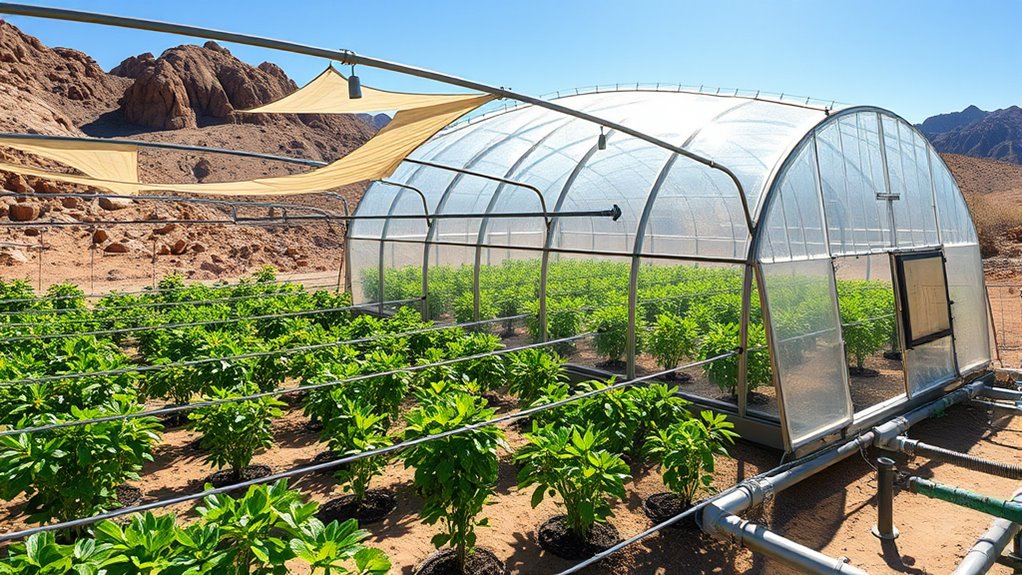
Proper water management and irrigation techniques are essential for maintaining healthy plants and maximizing greenhouse productivity. Efficient methods conserve water and assure your plants receive consistent moisture.
Consider using drip irrigation to deliver water directly to plant roots, reducing waste and evaporation. Rainwater harvesting is another effective strategy, capturing free water during rainy periods for later use, especially in dry seasons.
To optimize water use, regularly check soil moisture levels and adjust your watering schedule accordingly. Incorporate mulching to retain soil moisture and prevent evaporation.
Additionally, installing moisture sensors can help automate irrigation, guaranteeing plants get the right amount without overwatering. Implementing these techniques helps you maintain a sustainable, resilient greenhouse environment, even in extreme climates.
Protecting Plants From Harsh Winds and External Threats

Have you considered how harsh winds and external threats can damage your greenhouse plants? Strong gusts can break stems, while pests threaten your crops’ health. To protect them, implement shading solutions to reduce wind impact and heat stress. Additionally, pest prevention strategies like insect screens can keep unwanted visitors out. You can also reinforce your greenhouse structure with windbreaks or barriers. Use the table below to identify common threats and protective measures:
| Threat | Protective Measure |
|---|---|
| Harsh Winds | Windbreaks, sturdy framing |
| Pests | Insect screens, pest prevention |
| External Debris | Reinforced glazing, barriers |
| Excess Sunlight | Shading solutions, UV filters |
These steps help safeguard your plants and ensure a healthy, thriving greenhouse environment.
Choosing Plants That Thrive in Challenging Climates
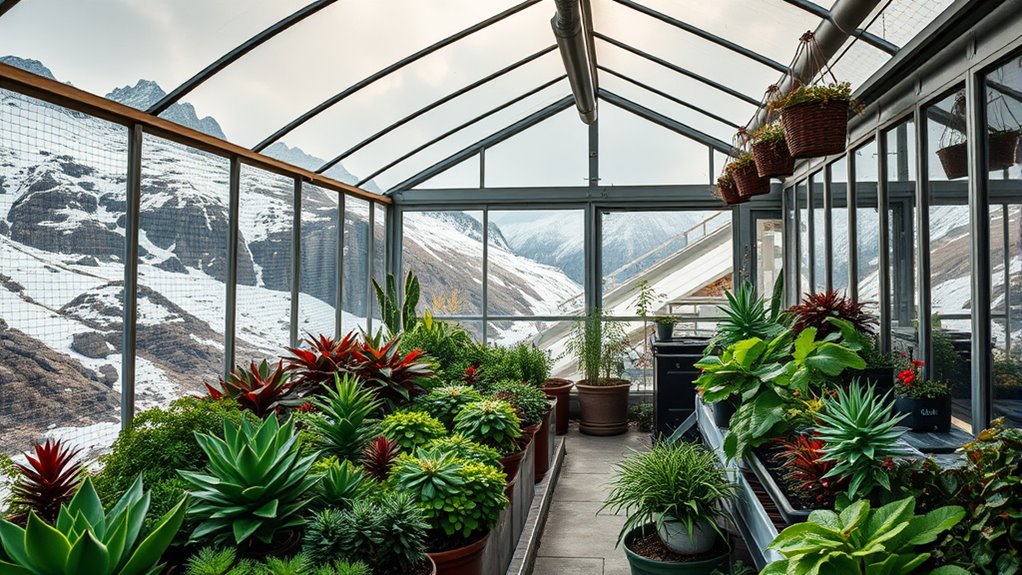
When selecting plants for tough climates, focus on resilient species that can handle extreme conditions.
You can also adapt your growing environment to better support these plants’ needs.
Selecting Resilient Species
Choosing resilient plant species is essential for successful greenhouse gardening in challenging climates. Selecting hardy varieties ensures they can withstand extreme temperatures and limited resources. Focus on plants that adapt easily, require minimal maintenance, and resist pests naturally.
When considering seed propagation, choose species with high germination success and quick growth cycles, reducing your vulnerability to pests and diseases. Opt for plants known for their resilience, such as drought-tolerant herbs or hardy vegetables.
Incorporate pest management strategies by selecting species less prone to infestations. Keep in mind that resilient plants often have strong root systems and robust foliage, making them better suited for extreme conditions.
Prioritize these traits when choosing your species to maximize your greenhouse’s productivity and sustainability.
Adapting Growing Conditions
Selecting plants that thrive in challenging climates requires understanding how to adapt your growing conditions effectively. You can improve your chances by focusing on pest prevention and soil enhancement techniques. Choose hardy species suited for extreme environments, and modify soil properties to optimize growth. Use mulch and organic matter to retain moisture and prevent pests. Consider the table below to visualize plant resilience:
| Plant Type | Soil Needs | Pest Resistance |
|---|---|---|
| Drought-tolerant | Well-drained, sandy | Natural deterrents |
| Cold-hardy | Loamy, insulated | Hard shells |
| Heat-resistant | Rich, moisture-retentive | Thick leaves |
| Shade-loving | Slightly acidic | Sparse foliage |
Adapting your greenhouse conditions with these strategies ensures your plants not only survive but flourish.
Frequently Asked Questions
How Can I Prevent Pests From Entering the Greenhouse in Extreme Climates?
To prevent pests from entering your greenhouse, focus on effective pest exclusion techniques. Install greenhouse barriers like fine mesh screens on vents and doors, ensuring they fit tightly to block pests.
Regularly inspect and maintain these barriers, and keep doors closed when not in use.
You can also implement additional measures like sticky traps and natural repellents. These steps create a secure environment, reducing pest intrusion and protecting your plants.
What Are the Best Methods to Monitor Greenhouse Temperature Remotely?
You can effectively monitor greenhouse temperature remotely by using remote sensors and wireless monitoring systems. These sensors transmit real-time data to your device, allowing you to keep a close eye on temperature changes without being physically present.
Install multiple sensors at different locations to guarantee accurate readings, and set up alerts for temperature fluctuations. This approach helps you maintain ideal conditions and respond swiftly to any climate variations.
How Do I Ensure Proper Ventilation in a High-Altitude Greenhouse?
Your high-altitude greenhouse faces the challenge of managing airflow like a mighty windstorm. To guarantee proper ventilation, install robust ventilation systems, including exhaust fans and adjustable vents, that can handle thin mountain air.
Use fans strategically for ideal airflow management, preventing heat buildup or cold pockets. Regularly monitor and adjust these systems, ensuring consistent air circulation to keep temperatures stable and plants thriving amidst the altitude’s extremes.
What Are Cost-Effective Insulation Options for Winter-Proofing?
To winter-proof your greenhouse cost-effectively, focus on insulation materials that offer good thermal resistance without breaking the bank. Use bubble wrap or foam boards for quick, affordable insulation.
Consider adding weatherstripping around doors and vents to prevent heat loss. These methods provide significant cost savings while maintaining warmth.
Regularly sealing gaps and using reflective materials can further boost insulation efficiency, ensuring your plants stay protected through harsh winters.
How Can I Reduce Energy Consumption While Maintaining Optimal Conditions?
Imagine a lighthouse guiding ships safely—your greenhouse can do the same for energy use. To reduce consumption while keeping perfect conditions, you can harness solar heating during sunny days and implement passive cooling strategies at night.
These methods minimize reliance on artificial energy, maintaining ideal temperature and humidity efficiently. By balancing natural light and ventilation, you protect your plants and cut costs, just like a lighthouse ensures safe passage without unnecessary energy expenditure.
Conclusion
By applying these resilient strategies, you can successfully grow plants even in extreme climates. Incorporating climate control, durable materials, and proper water management creates a microclimate tailored to your needs. Remarkably, some experts believe that designing greenhouses with natural windbreaks and solar orientation can considerably reduce energy use—supporting the idea that working with nature often yields the best results. With careful planning, you’ll turn challenging environments into thriving gardens.
